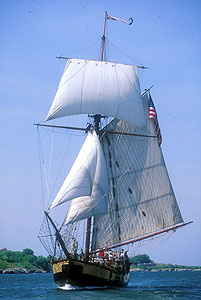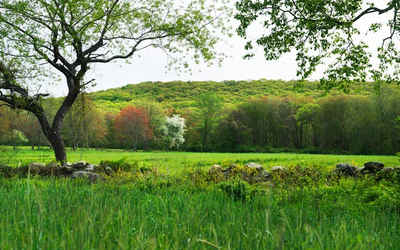Rhode Island State Flagship & Tall Flagship and Tall Ship Ambassador
"USS Providence" Replica

Adopted in 1992.
The "USS Providence" Replica was adopted in 1992. History comes alive aboard the Continental Sloop Providence! This 110' fully rigged sailing vessel is the faithful replica of John Paul Jones' first command. During her distinguished Naval career, the 12-gun Providence sank or captured 40 British enemy ships! She was a square-topsail-gaff-rigged sloop, the first ship commissioned into the Continental Navy and the first command of John Paul Jones. The new Providence is a replica built for the 1976 bicentennial. She has logged over 100,000 miles and is berthed in Providence, Rhode Island. The Providence is the official flagship and Tall Ship ambassador of the state of the State of Rhode Island and has won the "Best Dressed Vessel" award from the Sailing Ambassador.
Rhode Island State Flagship & Tall Flagship and Tall Ship Ambassador: "USS Providence" Replica
From the early 1775, British men-of-war, especially His Majesty's Frigate Rose, preyed on Rhode Island shipping and annoyed the colony's coast.
On 13 June Deputy Governor Nicholas Cooke, wrote James Wallace, the frigate's Captain demanding restoration of several ships which Rose had captured.
Two days later the Rhode Island General Assembly ordered the committee of safety to fit out two ships to defend the colony's shipping and appointed
a committee of three to obtain vessels. That day the committee chartered sloop Katy from John Brown of Providence and sloop Washington at the same
time. The General Assembly appointed Abraham Whipple, who had won fame in the burning of British armed schooner Gaspee in 1772, commander of Katy,
the larger ship, and made him commodore of the tiny fleet. Before sunset that day Whipple captured a tender to British Frigate Rose. Katy cruised in
Narragansett Bay through the summer protecting coastal shipping.
The supply of gun powder, an essential commodity scarce in the Continental Army throughout the Revolutionary War, was desperately low during the first
year of struggle for Independence. Late in the summer of 1775 the shortage in Washington's Army besieging Boston became so severe that he was unable
to use his artillery and his riflemen would have been unable to repel an attack had the British taken the offensive.
In an effort to obtain precious powder for the Continental Army, Cooke ordered Whipple to cruise for a fortnight off Sandy Hook, N.J., to intercept
a powder laden packet expected from London. He was then to proceed to Bermuda to capture the powder stored in the British magazine there. Katy departed
Narragansett Bay 12 September but caught no sight of the packet. Later upon reaching Bermuda, Whipple learned that the powder from the magazine was
already enroute to Philadelphia.
Soon after she returned to Providence, Katy was purchased by Rhode Island 31 October. Late in November, Katy sailed for Philadelphia carrying seamen
enlisted by Commodore Esek Hopkins in New England for continental service. Arriving 3 December, Katy was immediately taken into Continental service
and renamed Providence.
Captain Whipple assumed command of Columbus, a larger ship; and Captain John Hazard was placed in command of Providence, later formalized by a commission
from Congress dated 9 January 1776. The ships joined a squadron being formed by Congress under the command of "Commander in Chief of the Fleet of the
United Colonies" Esek Hopkins.
On 5 January 1776, Congress ordered Hopkins to sail for Chesapeake Bay and clear waters there of the ships of a fleet organized the previous autumn
by Governor Dunmore of Virginia. These English and Tory ships had ravaged the shores of the bay and the rivers which empty into it. Once Whipple's
ships had completed this task, they were to move south and clear the Carolina coast of enemy shipping before sailing North to Rhode Island to perform
a similar service.
Providence and her consorts departed Philadelphia early in January but, delayed by ice, did not get to sea until 17 February. Deeming it unwise to
cruise along the southern coast, Hopkins led his little fleet to Abaco in the Bahamas which they reached 1 March and staged for a raid on New Providence.
The next day they seized two sloops on which Hopkins placed a landing party of 200 marines and 50 sailors. At mid morning of the 3rd, under cover of
guns of Providence and Wasp, the Americans went ashore unopposed on the eastern end of New Providence and advanced toward Fort Montagne which opened
fire interrupting the invader's progress. The defenders spiked their guns and retreated to Fort Nassau. The next day Nassau surrendered and gave the
Americans the keys to the Fort. Hopkins then brought his ships into the harbor and spent a fortnight loading captured munitions, before heading home
17 March.
Off Block Island, Hopkin's ships captured schooner Hawk belonging to the British fleet at Newport 4 April and at dawn the next day took brig Bolton.
That evening the Americans added a brigantine and a sloop, both from New York, to their list of prizes.
About 0100, 6 April, Andrew Doria sighted HMS Glasgow, a 20-gun sloop carrying dispatches from Newport to Charleston. The American fleet engaged the
enemy ship for one and one-half hours before she turned back and fled back toward Newport. After daylight Hopkins ordered his ships to give up the
chase and headed with his fleet and prizes for New London where they arrived on the 8th.
On 10 May, John Paul Jones assumed command of Providence with temporary rank of Captain. After a voyage to New York returning to the Continental Army
about 100 soldiers whom Washington had lent to Hopkins to help man the American fleet, and after returning to Providence, Jones hove down the ship
to clean her bottom and sailed 13 June escorting Fly to Fisher's Island at the entrance to Long Island Sound. Enroute he saved a brigantine bringing
munitions from Hispanola from British frigate HMS Cerberus.
Providence next escorted a convoy of colliers to Philadelphia arriving 1 August. There a week later, Jones received his permanent commission as Captain.
On the 21st, Providence departed the Delaware Capes to begin an independent cruise, and in a few days took brigantine Britannia and sent the whaler
into Philadelphia under a prize crew on 1 September daring seamanship enabled Jones to escape from British frigate Solebay. Two days later Providence
captured Sea Nymph, carrying sugar, rum, ginger, and oil, and sent the Bermudan brigantine to Philadelphia. On the 6th Providence caught brigantine
Favourite carrying sugar from Anitgua to Liverpool, but HMS Galatea recaptured the prize before she could reach an American port.
Turning north, Jones headed for Nova Scotia, and on 20 September escaped another frigate before reaching Canso two days later. There he recruited men
to fill the vacancies created by manning his prizes, burned a British fishing schooner, sank a second, and captured a third besides a shallop which
he used as a tender. Moving to Ile Madame, Providence took several more prizes fishing there before riding out a severe storm. One more prize, whaler
Portland surrendered to Providence before she returned to Narragansett Bay 8 October.
While Providence was at home, Hopkins appointed Jones Commander Alfred, a larger ship and the Commander in Chief's flagship on the expedition to the
Bahamas. Shortly thereafter, Capt. Hoysted Hacker took command of Providence. The two ships got under way 11 November. After ten days they took brigantine
Active and the next day took armed transport Mellish carrying winter uniforms and military supplies for the British Army. On the 16th they captured
snow Kitty. The next night, Providence, troubled by leaks which had developed during bad weather on the cruise, headed back for Rhode Island and arrived
Newport two days later.
The British seized Narragansett Bay in December 1776 and Providence with other American vessels there retired up the Providence River. In February
1777, under Lt. Jonathan Pitcher, providence ran the British blockade; and after putting into New Bedford, cruised to Cape Breton, where she captured
a transport brig loaded with stores and carrying two officers and 25 men of the British Army besides her crew. Under command of Capt. J.P. Rathbun,
Providence made two cruises on the coast and about mid-January 1778, sailed from Georgetown, N.C., again bound for New Providence in the Bahamas, this
time alone. On 27 January she spiked the guns of the fort at Nassau, taking military stores including 1600 pounds of powder, and released 30 American
prisoners. She also made prize of a 16-gun British ship and recaptured five other vessels which had been brought in by the British, On 30 January the
prizes were manned and sailed away. Providence, with her armed prize, put into New Bedford.
During the early part of April 1779 Providence was ordered to make a short cruise in Massachusetts Bay and along the coast of Maine. She later sailed
south of cape Cod and on 7 May, captured HMS Brig Diligent, 12 guns, off Sandy Hook. She fired two broadsides and a volley of muskets during the engagement
and Diligent, with mast rigging and hull cut to pieces, was forced to surrender. She then was assigned to Commodore Saltonstall's squadron which departed
Boston 19 July 1779 and entered Penobscot Bay 25 July. She was destroyed by her crew, with other American vessels in the Peneobscot River, 14 August
1779, to prevent her falling into the hands of the British.
Rhode Island Law
The law designating the Continental sailing vessel known as "Providence" as the official Rhode Island state flagship is found in the State of Rhode Island General Laws, Title 42, Chapter 1042-4, Section 42-4-14
TITLE 42
State Affairs and Government
CHAPTER 42-4
State Emblems
SECTION 42-4-14
§ 42-4-14 State flagships. - The replica of the Continental sailing vessel known as "Providence" is hereby designated as the official flagship
and tall ship ambassador of the state.
History of Section.
(P.L. 1993, ch. 366, § 1.)








